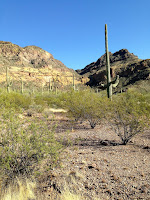Okay. We finally made it to Roswell! If you’re at all interested
in extraterrestrial contacts with Earth, science fiction or otherwise, then you’ve
probably heard of Roswell. Would there
be ET vibes in this town or did visitors from outer space leave any noticeable marks
on the area?
Roswell, New Mexico, is all about the claimed discovery of
UFO debris in 1947, on a farm, about 30 or so miles northwest of the town. The
site of the found UFO material was investigated by the US Army Air Corps as
soon as they got wind of it from the local sheriff’s office. And it was pretty
quickly deemed to be nothing more than debris from a high altitude weather
balloon. The area of the sighting and
the case itself was closed.
At the National UFO Museum in Roswell, the whole story is
documented with photos and signed affidavits from witnesses and/or confidantes
of the witnesses. There were deathbed type confessions made when the witness
knew he/she could no longer be punished for telling “the truth.”
Both sides – the local UFO “discoverers” side and the
military side– were presented through photos and newspaper clippings and signed
affidavits. The side that is most
weighted is the “evidence” showing that the incident was aggressively denied by
the military and quickly delegated to Top Secret category which then prevented
anyone from talking publicly about it.
It’s not just the found debris that is still in question.
There were also stories of seeing 3 or 4 aliens at the “crash” sight and
conjectures of military officials taking them away to hide them.
 Fact or fiction? The mystery lives on – especially in
Roswell where the “vibes” are kept alive by local merchants and shopkeepers.
Hey, it’s been good for business!
Fact or fiction? The mystery lives on – especially in
Roswell where the “vibes” are kept alive by local merchants and shopkeepers.
Hey, it’s been good for business!















































